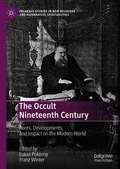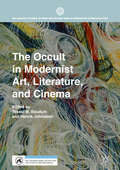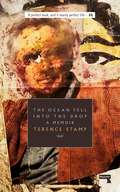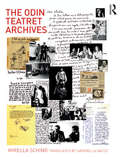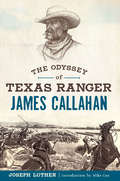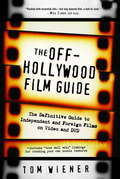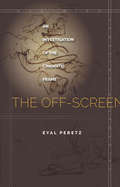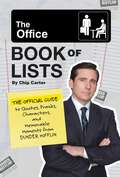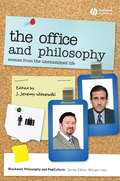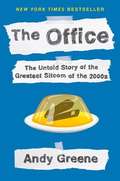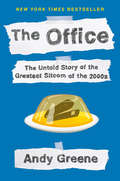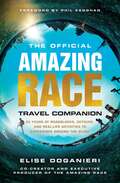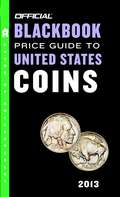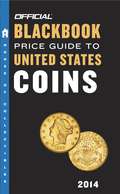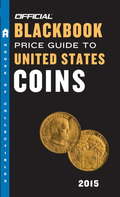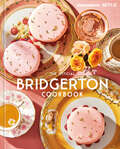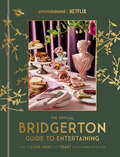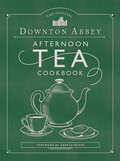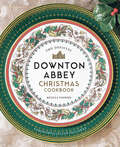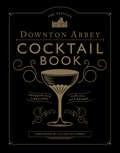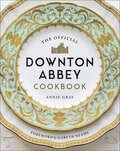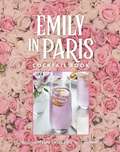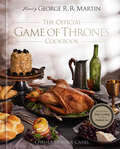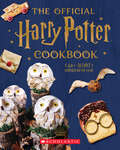- Table View
- List View
The Occult Nineteenth Century: Roots, Developments, and Impact on the Modern World (Palgrave Studies in New Religions and Alternative Spiritualities)
by Franz Winter Lukas PokornyThe nineteenth century witnessed a proliferation of alternative religious currents and practices, appropriating earlier traditions, entangling geographically distinct spiritual discourses, and crafting a repository of mindscapes eminently suitable to be accommodated by later generations of thinkers and practitioners. Penned by specialists in the field, this volume examines important themes and figures pertaining to this occult amalgam and its resonance into the twentieth century and beyond. Global guises of the occult, ranging from the Americas and Europe to India, are variously addressed, with special attention to the crucial role of mesmerism and the origins of modern yoga.
The Occult in Modernist Art, Literature, and Cinema (Palgrave Studies In New Religions And Alternative Spiritualities Ser.)
by Tessel M. Bauduin Henrik JohnssonMany modernist and avant-garde artists and authors were fascinated by the occult movements of their day. This volume explores how Occultism came to shape modernist art, literature, and film. Individual chapters examine the presence and role of Occultism in the work of such modernist luminaries as Rainer Maria Rilke, August Strindberg, W.B. Yeats, Joséphin Péladan and the artist Jan Švankmaier, as well as in avant-garde film, post-war Greek Surrealism, and Scandinavian Retrogardism. Combining the theoretical and methodological foundations of the field of Esotericism Studies with those of Literary Studies, Art History, and Cinema Studies, this volume provides in-depth and nuanced perspectives upon the relationship between Occultism and Modernism in the Western arts from the nineteenth century to the present day.
The Ocean Fell into the Drop: A Memoir
by Terence StampDuring my first visit to the cinema the empathy I felt from Gary Cooper was life-changing, and a secret dream was born in the darkened auditorium. Later, my forays to the East revealed an original take on humanity which fell into two categories: those who remembered and those who didn’t. The former by teaching the latter could transmit this memory, and communicate this spark of creation directly into the being of the other.The Ocean Fell into the Drop is a different kind of showbusiness memoir, one that traces Terence Stamp’s twin obsessions, acting and mysticism, and the relationship the two have to each other for him, through the trajectory of his life. On the way he discusses his directors, Fellini, Loach, Pasolini; actors, Olivier, Brando and Redgrave; and spiritual masters, Krishnamurti and Hazarat Inayat Khan, as well as his family, life in the East End, Sufism and style.
The Odin Teatret Archives
by Mirella SchinoThe Odin Teatret Archives presents collections from the archives of one of the foremost reference points in global theatre. Letters, notes, work diaries, articles, and a wealth of photographs all chart the daily activity that underpins the life of Odin Teatret, telling the adventurous, complex stories which have produced the pioneering work that defines Odin's laboratory approach to theatre. Odin Teatret have been at the forefront of theatrical innovation for over fifty years, devising new strategies for actor training, knowledge sharing, performance making, theatrical alliances, and ways of creating and encountering audiences. Their extraordinary work has pushed boundaries between Western and Eastern theatre; between process and performance; and between different theatre networks across the world. In this unique volume, Mirella Schino brings together a never before seen collection of source materials which reveal the social, political, and artistic questions facing not just one groundbreaking company, but everyone who tries to make a life in the theatre.
The Odyssey of Texas Ranger James Callahan
by Joseph LutherJames Callahan entered Texas armed, a quixotic young man enlisted in the Georgia Battalion for the cause of independence. He barely survived the 1836 Battle of Refugio and the Goliad Massacre. Undaunted by the perils of his adopted home, he remained in the line of fire for the next twenty-one years, fighting to protect Texas settlers from Apaches, Comanches, Seminoles, Kickapoos, outlaws, mavericks and the Mexican army. As a Texas Ranger, he rode with the legendary men of Seguin and San Antonio. In 1855, he commanded the punitive expedition into Mexico that bears his name, a fiasco that has been shrouded by mystery and shadowed by controversy ever since. In this first-ever biography, Joseph Luther traces the tragic course of the wayfarer who crossed so much of the Texas frontier and created so much of its story.
The Off-Hollywood Film Guide: The Definitive Guide to Independent and Foreign Films on Video and DVD
by Tom WienerThe Off-Hollywood Film Guide cuts through the clutter of the thousands of films currently available on video and DVD by specifically catering to independent- and foreign-film enthusiasts. In addition to a list of essential must-see films, this guide includes hundreds of entries, each with brief commentary and a list of pertinent details, such as release date, cast, director, awards garnered, special DVD features, and double-feature suggestions. The listings are also cross-referenced by genre, director, actors, and country of origin.
The Off-Screen: An Investigation of the Cinematic Frame
by Eyal PeretzFrom the Renaissance on, a new concept of the frame becomes crucial to a range of artistic media, which in turn are organized around and fascinated by this frame. The frame decontextualizes, cutting everything that is within it from the continuity of the world and creating a realm we understand as the realm of fiction. The modern theatrical stage, framed paintings, the novel, the cinematic screen—all present us with such framed-off zones. Naturally, the frame creates a separation between inside and out. But, as this book argues, what is outside the frame, what is offstage, or off screen, remains particularly mysterious. It constitutes the primary enigma of the work of art in the modern age. It is to the historical and conceptual significance of this "off" that this book is dedicated. By focusing on what is outside the frame of a work of art, it offers a comprehensive theory of film, a concise history of American cinema from D.W. Griffith to Quentin Tarantino, and a reflection on the place and significance of film within the arts of modernity in general.
The Office Book of Lists: The Official Guide to Quotes, Pranks, Characters, and Memorable Moments from Dunder Mifflin
by Chip CarterPacked with compelling facts and trivia from all nine seasons, The Office Book of Lists breaks down the memorable series in a collection of 100+ easy-to-digest lists focusing on themes and characters in an irresistible package.Each entry in this comprehensive book celebrates another corner of The Office universe and offers new discoveries and facts concerning cherished characters and themes. From the most hilarious pranks played at Dunder Mifflin to Michael&’s best "That's What She Said" moments, each list will delight fans and remind them why The Office is one of the most popular comedy series of all time. Each list also helpfully indicates season and episode. Lists include: Michael&’s Inappropriate BehaviorSchrute Family History, Customs, and RitualsJim&’s PranksAngela&’s MoralsCreed ThoughtsAndy&’s Musical MomentsOffice RomancesChristmas Secret Santa GiftsField TripsKelly&’s CrushesAnd more!Including full-color photos and visuals throughout, The Office Book of Lists is an officially licensed must-have collector's item for the ultimate fan.The Office is a trademark and copyright of Universal Content Productions LLC. Licensed by Universal Studios 2020. All Rights Reserved.
The Office and Philosophy: Scenes from the Unexamined Life
by J. Jeremy WisnewskiNot many books refer to Hooters restaurant and philosopher John Stuart Mill on the same page. Focusing on the American/British television comedy series "The Office", Wisnewski (Hartwick College, Oneonta, NY) and fellow philosophers draw lessons from the quirky analysis of the unexamined life portrayed in its episodes. For example, one chapter is entitled: "Pam and Jim on the Make: The Epistemology of Self-Deception".
The Office: The Untold Story Of The Greatest Sitcom Of The 2000s
by Andy GreeneWhen did you last hang out with Jim, Pam, Dwight, Michael, and the rest of Dunder Mifflin? It might have been back in 2013, when the series finale aired . . . or it might have been last night, when you watched three episodes in a row. But either way, fifteen years after the show first aired, it's more popular than ever, and fans have only one problem--what to watch, or read, next. <P><P> Fortunately, Rolling Stone writer Andy Greene has that answer. In his brand-new oral history, The Office: The Untold Story of the Greatest Sitcom of the 2000s, Greene will take readers behind the scenes of their favorite moments and characters. Greene gives us the true inside story behind the entire show, from its origins on the BBC through its impressive nine-season run in America, with in-depth research and exclusive interviews. <P><P>Fans will get the inside scoop on key episodes from "The Dundies" to "Threat Level Midnight" and "Goodbye, Michael," including behind-the-scenes details like the battle to keep it on the air when NBC wanted to pull the plug after just six episodes and the failed attempt to bring in James Gandolfini as the new boss after Steve Carell left, spotlighting the incredible, genre-redefining show created by the family-like team, who together took a quirky British import with dicey prospects and turned it into a primetime giant with true historical and cultural significance. <P><P> Hilarious, heartwarming, and revelatory, The Office gives fans and pop culture buffs a front-row seat to the phenomenal sequence of events that launched The Office into wild popularity, changing the face of television and how we all see our office lives for decades to come.
The Office: The Untold Story of the Greatest Sitcom of the 2000s: An Oral History
by Andy GreeneThe untold stories behind The Office, one of the most iconic television shows of the twenty-first century, told by its creators, writers, and actors When did you last hang out with Jim, Pam, Dwight, Michael, and the rest of Dunder Mifflin? It might have been back in 2013, when the series finale aired . . . or it might have been last night, when you watched three episodes in a row. But either way, fifteen years after the show first aired, it&’s more popular than ever, and fans have only one problem--what to watch, or read, next. Fortunately, Rolling Stone writer Andy Greene has that answer. In his brand-new oral history, The Office: The Untold Story of the Greatest Sitcom of the 2000s, Greene will take readers behind the scenes of their favorite moments and characters. Greene gives us the true inside story behind the entire show, from its origins on the BBC through its impressive nine-season run in America, with in-depth research and exclusive interviews. Fans will get the inside scoop on key episodes from "The Dundies" to "Threat Level Midnight" and "Goodbye, Michael," including behind-the-scenes details like the battle to keep it on the air when NBC wanted to pull the plug after just six episodes and the failed attempt to bring in James Gandolfini as the new boss after Steve Carell left, spotlighting the incredible, genre-redefining show created by the family-like team, who together took a quirky British import with dicey prospects and turned it into a primetime giant with true historical and cultural significance. Hilarious, heartwarming, and revelatory, The Office gives fans and pop culture buffs a front-row seat to the phenomenal sequence of events that launched The Office into wild popularity, changing the face of television and how we all see our office lives for decades to come.
The Official Amazing Race Travel Companion: More Than 20 Years of Roadblocks, Detours, and Real-Life Activities to Experience Around the Globe
by Elise DoganieriDiscover unique destinations and take your vacation plans to the next level with these travel ideas from the official companion to the blockbuster reality show, The Amazing Race. For more than twenty years, The Amazing Race has introduced viewers to unique travel destinations in ninety-two countries across the globe. Pairing challenges with cultural touchpoints of the locations visited, The Amazing Race averages 10 million viewers per season. This fanbook-meets-travel guide will cover six continents and thirty-two countries, including activities and places to visit at each destination. In addition to region-specific recommendations of destinations and activities from the show&’s history, The Official Amazing Race Travel Companion will feature: -A never-before-seen &“behind the scenes&” snapshot of how the show is made, who they hire, and how destinations are chosen -An introduction by Elise Doganieri and Bertram van Munster, cocreators of The Amazing Race -A foreword by host Phil Keoghan -And many more fun surprises! Perfect for the fan or avid traveler in your life, The Official Amazing Race Travel Companion will satisfy any craving for adventure while traveling! TM Amazing Race Productions Inc. © 2022 Amazing Race Productions Inc. & ABC Studios Inc. All Rights Reserved.
The Official Blackbook Price Guide to United States Coins 2013, 51st Edition
by Thomas E. HudgeonsFor over fifty years, The Official Blackbook Price Guide to United States Coins 2013 has been the bestselling sourcebook for collectors. Reflecting the current skyrocketing prices of gold and silver, this guide has all the information you need to become a knowledgeable coin collector. Features include: *Over 18,000 prices *Values for every U.S. coin ever minted *An updated market review that traces current trends in collecting and investing *Hundreds of coin illustrations and a fast-find index for easy identification *Extensive information on buying and selling coins at auction, coins shows, online, and through the mail
The Official Blackbook Price Guide to United States Coins 2014, 52nd Edition
by Thomas E. HudgeonsFor over fifty years, The Official Blackbook Price Guide to United States Coins has been the bestselling sourcebook for collectors. Filled with the most current values and the latest market reports, this updated edition has all the information you need to become a knowledgeable coin collector. Features Include:*Over 18,000 prices*Values for every U.S. coin ever minted*An updated market review that traces current trends in collecting and investing*Hundreds of coin illustrations and a fast-find index for easy identification*Extensive information on buying, selling, and grading coins at auction, online, and through the mail
The Official Blackbook Price Guide to United States Coins 2015, 53rd Edition
by Thomas E. HudgeonsFor over fifty years, The Official Blackbook Price Guide to United States Coins has been the bestselling sourcebook for collectors. Filled with the most current values and the latest market reports, this updated edition has all the information you need to become a knowledgeable coin collector. Features Include:* Over 18,000 prices* Values for every U.S. coin ever minted* An updated market review that traces current trends in collecting and investing* Hundreds of coin illustrations and a fast-find index for easy identification* Extensive information on buying, selling, and grading coins at auction, online, and through the mail
The Official Bridgerton Cookbook
by Regula YsewijnTake a seat at the most sumptuous tables of the ton with over seventy recipes from the world of Bridgerton, the hugely popular Shondaland series on Netflix.The Official Bridgerton Cookbook allows you to prepare a feast worthy of Queen Charlotte herself, with dishes like Lady Featherington&’s towering Salmagundi salad, stacked high with persimmon and watercress, or Colin Bridgerton&’s Aegean Fasolada. For an intimate tête-à-tête, share a glass of mixed-citrus Vin d&’Orangerie and browned-butter Artichokes for Two. If you long for something sweet, try Queen Charlotte&’s Pink Perfection, an oversized macaron finished with fresh raspberries and edible gold, with a side of That Ice Cream, a no-churn, bourbon-cherry treat fit for the Duke of Hastings.Packed with quotes from favorite characters, show images, and fabulously photographed recipes, this gorgeous book invites fans to the Regency banquet table that is Bridgerton, with food and drink that entertains and delights.
The Official Bridgerton Guide to Entertaining: How to Cook, Host, and Toast Like a Member of the Ton: A Cookbook
by Emily TimberlakeEntertain like a queen with these forty recipes for Bridgerton-style food and drink in the first official cookbook from this hugely popular Shondaland series on Netflix. Whether it&’s a sumptuous lawn party, a high tea, or a boozy late-night salon, this gorgeous cookbook delivers recipes for finger food, cocktails, and entertaining ideas that help you recreate the high society of Bridgerton in your own home. Host the perfect pique-nique, complete with the Duke&’s favorite Gooseberry Hand Pies and a rousing game of Pall Mall (played the Bridgerton way, of course). Create grazing boards with recipes like Roasted Pork Belly Skewers and Beet-Dyed Deviled Eggs that are perfect for a stylish watching party. Evoke the delightful decadence of Lady Danbury&’s Den of Iniquity with Sausage-Stuffed Mushroom Caps, an espresso martini, and an old-fashioned game of chance. These forty recipes have been developed with a modern audience in mind, offering mocktail, vegetarian, and gluten-free options to ensure that no fan is left hungry. They are presented alongside mouth-watering food photography, stills from the show, and sidebars explaining essential expertise, such as how to address a Marquis, execute the perfect curtsy, or build a macaron tower sturdy enough to last the night. It&’s time to entertain, Bridgerton-style.
The Official Doctor Who and the Daleks Book
by John Peel Terry NationEXTERMINATE! EXTERMINATE! In December 1963, a seven-part serial called "The Daleks" appeared on British television-catapulting the offbeat new series Doctor Who to instant international fame. Through the years, the Daleks-half-robot, half- organic, totally evil beings-have returned again and again to firmly establish themselves as the Doctor's greatest foes. Now, for the first time, Terry Nation, creator of the Daleks, has teamed with John Peel to tell the complete story of the Dalek.
The Official Downton Abbey Afternoon Tea Cookbook: Teatime Drinks, Scones, Savories And Sweets (Downton Abbey Cookery)
by Downton AbbeyA guide to this treasured English tradition with recipes, serving and decorum tips, and culinary history—as well as delightful photos from the series. Afternoon tea is a revered English tradition—and no one knows better how to prepare and enjoy a proper tea than the residents of Downton Abbey. With this alluring and vibrant cookbook, fans of the PBS series and anglophiles alike can stage every stylish element of this cultural staple of British society at home. Spanning sweet and savory classics—like Battenberg Cake, Bakewell Tart, toffee puddings, cream scones, and tea sandwiches—the recipes capture the quintessential delicacies of the time, and the proper way to serve them. This charming cookbook also features a detailed narrative history and extols the proper decorum for teatime service, from tea gowns and tearooms to preparing and serving tea. Gorgeous food photographs, lifestyle stills from the television series and recent movie, and quotes bring the characters of Downton Abbey—and this rich tradition—to life in contemporary times.
The Official Downton Abbey Christmas Cookbook (Downton Abbey Cookery)
by Regula Ysewijn&“You don&’t have to be an English aristocrat to enjoy Yorkshire Pudding . . . or the other indulgent dishes in The Official Downton Abbey Christmas Cookbook.&” —San Jose Mercury News Take a seat at the Christmas table at Downton Abbey, the historic British estate at the heart of the popular PBS series. Downton fans will appreciate this enticing collection of more than sixty classic British holiday recipes from the Edwardian era, evocative narratives about Christmas traditions, and seasonal anecdotes from the award-winning series. Colorful photographs of finished dishes, fan-favorite moments from the Christmas episodes, and excerpts of character quotes bring the spirit of the holidays to life. Discover feast-worthy dishes from roast beef to figgy pudding and create a classic Christmas celebration with all the warmth and elegance of Downton.
The Official Downton Abbey Cocktail Book: Appropriate Libations for All Occasions (Downton Abbey Cookery)
by Downton AbbeyRaise a glass to the elegant past with this collection of drinks recipes inspired by the beloved historical drama. Cocktails were introduced in the drawing rooms of Downton Abbey in the 1920s, when US prohibition inspired the popularity of American-style bars and bartenders in Britain. This well-curated selection of recipes is organized by the rooms in the Abbey in which the drinks were served, and spans everyday sips to party drinks plus hangover helpers and more. In addition to classic concoctions like a Mint Julep, Prince of Wales Punch, and Ginger Beer, this collection features character-specific variations such as Downton Heir, Turkish Attaché, The Valet, and The Chauffeur. The recipes reflect drinks concocted and served upstairs and down, as well as libations from village fairs, cocktail parties, and restaurant menus typical of the time. The book also includes tips, historical trivia, and over forty color photographs featuring cocktails and cast members.
The Official Downton Abbey Cookbook (Downton Abbey Cookery)
by Annie GrayRecipes, notes, and photos from the show, &“sumptuously presented in spectacular fashion even the blessed Lady Mary would approve of&” (Chowhound). Food historian and show consultant Annie Gray gives a rich and fascinating insight into the background of the dishes that were popular between 1912 and 1926, when Downton Abbey is set—a period of tremendous change and conflict, as well as culinary development. With a foreword by executive producer and co-creator Gareth Neame, and featuring over one hundred stunning color photographs, The Official Downton Abbey Cookbook also includes a special section on hosting Downton-themed dinner parties and presents stills from the TV series and film. Notes on the etiquette and customs of the times, quotes from the characters, and descriptions of the scenes in which the foods appear provide vivid context for the dishes. The recipes are grouped by occasion, which include breakfast; luncheons and suppers; afternoon tea and garden parties; picnics, shoots and race meets; festivities; upstairs dinner; downstairs dinner; downstairs supper and tea; and the still room. Whether adapted from original recipes of the period, replicated as seen or alluded to on screen, or typical of the time, all the recipes reflect the influences found on the Downton Abbey tables. &“A truly useful work of culinary history.&” —Publishers Weekly &“Will let you live your best Dowager Countess life.&” —Food & Wine
The Official Emily in Paris Cocktail Book: Glamorous Mixed Drinks for Any Time of Day
by Weldon OwenSip your way through Paris with 50+ recipes for drinks, from classic cocktails to contemporary non-alcoholic refreshers. Enjoy a taste of Emily&’s glamorous life with favorites such as the Sancerre Breakfast Wine Cocktail and the Champagne Spray. Stir up classic French staples such as the French 75 and the Boulevardier, or imbibe with new nonalcoholic twists on old favorites. Featuring lavish photos from the show, fan-favorite quotes; and tips for throwing cocktail fêtes, viewing parties, and drinking games, fans of Emily in Paris, Francophiles, and home bartenders alike can celebrate the hit series and French culture with this must-have cocktail book. 50+ RECIPES INSPIRED BY EMILY IN PARIS: With a broad selection of French classics, elegant wine cocktails, fan-inspired drinks, and more, The Official Emily in Paris Cocktail Book celebrates classic and contemporary libations inspired by the Netflix series RECIPES FOR EVERY OCCASION: Whether you&’re shaking up nonalcoholic sippers perfect for the beaches of Southern France, stirring together a batch of punch for a watch party, or pouring pitchers of brunch margs for the gals, The Official Emily in Paris Cocktail Book is a priceless guide to entertaining and imbibing for every occasion NOT JUST COCKTAILS: Includes tasty mocktail recipes as well. THE FIRST OFFICIAL EMILY IN PARIS COCKTAIL GUIDE: The only cocktail volume with recipes officially from the set of Emily in Paris. The perfect gift for the Emily in Paris fan in your life INSPIRING IMAGES: Filled with beautiful full-color photography of the drinks to help ensure success.
The Official Game of Thrones Cookbook: Recipes from King's Landing to the Dothraki Sea
by Chelsea Monroe-CasselFrom the world of George R. R. Martin&’s A Song of Ice and Fire comes a collection of 80 delicious recipes inspired by the histories of Westeros, Essos, and beyond.For those who long to dine with the Dragonlords of Old Valyria or quaff a cup of mead with King Robert I, The Official Game of Thrones Cookbook unlocks the vast culinary world of George R. R. Martin&’s A Song of Ice and Fire. Presented as the in-world manuscript of a Citadel maester, these eighty recipes take the reader on a delectable journey throughout the Seven Kingdoms, across the Narrow Sea, and back into the annals of history.The book is created by Chelsea Monroe-Cassel, who tends the popular &“Inn at the Crossroads&” food blog and co-authored A Feast of Ice and Fire. Her Maester Alton is curious, food-obsessed, and loves the fare of the highborn and small folk alike. His recipes evoke the world&’s regions, history, and stories in a charming and knowledgeable voice.The eight chapters offer recipes for every meal of the day, including Dothraki Blood Pie, Crown Roast of Boar&’s Ribs, Dornish Creamcakes, Redwyne Roasted Grapes, Seaweed Ship&’s Biscuits, Barley Griddle Cakes, Winter Town Wassail. Recipes are illustrated by mouthwatering food photography and stunning woodcut illustrations. A resource section suggests menus by region, so you can hold a feast in Riverlands, The Wall, or Braavos. Complete with an introduction by George R. R. Martin, The Official Game of Thrones Cookbook transports you to a much-loved world where trestle tables groan with sumptuous feasts, goblets overflow with mead, and winter is always coming.
The Official Harry Potter Cookbook: 40+ Recipes Inspired by the Films
by Joanna FarrowCreate delicious recipes inspired by the Wizarding World in The Official Harry Potter Cookbook -- the companion to the #1 New York Times bestseller The Official Harry Potter Baking Book ! Cook your way through Hogwarts and the rest of the Wizarding World in this official cookbook inspired by the Harry Potter films! This gorgeous book is packed with full-color photography and over 40 recipes -- both savory and sweet -- including snacks, desserts, drinks, and meals fit for a Hogwarts feast!Whip up some Owl Post savory crepes, Hagrid’s hearty soup, Draco Malfoy blondies, Sir Cadogan’s sword kebabs, a troll bogey smoothie, and more! Nutritional and dietary information is provided throughout, along with gluten-free, vegetarian, and vegan options. Plus, this cookbook features tons of cooking tips and advice for the youngest aspiring chefs, including recipes with step-by-step instructions that are easy for kids to follow. The perfect book for any beginning cook and Harry Potter fan!
